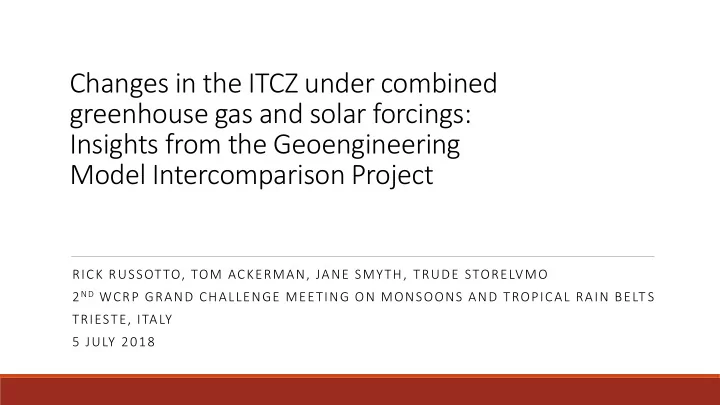

Changes in the ITCZ under combined greenhouse gas and solar forcings: Insights from the Geoengineering Model Intercomparison Project RICK RUSSOTTO, TOM ACKERMAN, JANE SMYTH, TRUDE STORELVMO 2 ND WCRP GRAND CHALLENGE MEETING ON MONSOONS AND TROPICAL RAIN BELT S TRIESTE, ITALY 5 JULY 2018
Solar geoengineering: How to cool the Earth from the SW side? Marine Cloud Brightening Mirrors/Dust in Space Stratospheric Aerosol Injection Climate Central Bewick et al., 2012 John McNeill 2
Why study geoengineering with climate models? Science to inform policy debate ◦ Could it work? ◦ How much is necessary? ◦ Drawbacks/side effects/risks? Better understand climate response to solar vs. greenhouse forcings ◦ Detection/attribution of climate change ◦ Paleoclimates ◦ Aerosol & volcanic forcings 3
The Geoengineering Model Intercomparison Project (GeoMIP) Experiment G1: equal, opposing forcings Abruptly quadruple CO 2 Reduce solar constant for zero net forcing/ zero global mean temperature change Analysis procedure: Average years 11-50 Subtract out CMIP5 piControl average Kravitz et al., Atmos. Sci. Lett. , 2011 4
G1: Participating Models (fully coupled atmosphere-ocean GCMs) Model Country Solar constant reduction Global mean temperature change (K) BNU-ESM 4.4 % 0.03 Can-ESM2 4.0 % -0.01 CCSM4 4.1 % 0.23 CESM1-CAM5.1-FV 4.7 % -0.16 CSIRO-Mk3L-LR 3.2 % 0.03 GISS-E2-R 4.5 % -0.29 HadGEM2-ES 3.9 % 0.24 IPSL-CM5A-LR 3.5 % 0.11 MIROC-ESM 5.0 % -0.07 MPI-ESM-LR 4.7 % -0.01 NorESM1 4.0 % -0.04 5
Map of precipitation change Global mean Multi-model precipitation is reduced mean map: because sunlight hatched where reduction reduces fewer than 9 of 12 models agree surface evaporation. on sign of change Strongest in tropics, (Kravitz et al., J. Geophys. Res. except equatorial Atmos. , 2013a) Atlantic/Pacific. 6
ITCZ shifts in individual models If one hemisphere is Russotto and preferentially cooled, Ackerman, tend to have ITCZ shift Atmos. Chem. towards other Phys., 2018 hemisphere. 7
Anticorrelation with cross-equatorial energy transport Useful for Russotto and attributing sources Ackerman, of inter-model Atmos. Chem. spread. Phys., 2018 8
Attribution experiments with moist EBM Following procedure of, e.g. , Frierson and Hwang (2012) Plug TOA radiation changes associated with various physical processes into EBM. How does cross-equatorial MSE transport respond? Cloud adjustments largest source of inter-model spread. Russotto and Ackerman, Atmos. Chem. Phys., 2018 9
Seasonal migration of ITCZ Climatology Seasonal migration dampened in geoengineered climate. Reason: preferential cooling Waliser and Gautier, of summer hemisphere. J. Climate, 1993 Multi-model mean ITCZ position 10
Seasonal migration of ITCZ Climatology Damping occurs in every model. Key Waliser and Gautier, piControl J. Climate, 1993 G1 Annual JFM JAS Mean North → Smyth et al., Atmos. Chem. Phys., 2017 11
ITCZ shift vs. inter-hemispheric temperature change in seasons Boreal Summer Boreal Winter Smyth et al., Atmos. Chem. Phys., 2017 12
Summary Under 4xCO 2 and reduced solar constant, such that net forcing is zero: ◦ Some models exhibit ITCZ shifts. ◦ The cloud response is the largest source of inter-model spread therein. ◦ The seasonal migration of the ITCZ is weakened due to preferential cooling of the summer hemisphere. Unresolved questions: ◦ How much of annual mean ITCZ narrowing is due to the seasonal migration reduction? ◦ CO 2 + solar responses: how linear? 13
14
Slides taken out 15
What if we injected in only one hemisphere? Precipitation change from injecting 5 Tg SO 2 /year into Northern Hemisphere (a) or Southern Hemisphere (b) in HadGEM2-ES model. (Haywood et al., 2013) 16
Climatological Northward Energy Transport by the Atmosphere Atmosphere moves energy from equator to poles. 17
Change in Northward Energy Transport Decrease in poleward The reduced energy transport! poleward energy transport limits Opposite of global the polar warming case. warming. Moisture transport accounts for discrepancy. 18
Recommend
More recommend